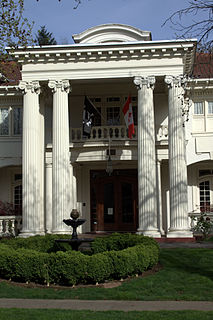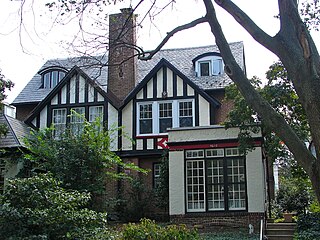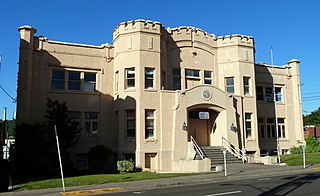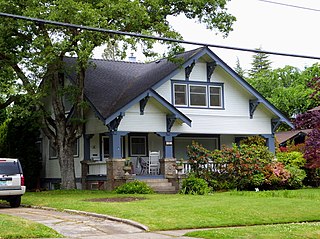
McMenamins is a family-owned chain of brewpubs, breweries, music venues, historic hotels, and theater pubs in the Pacific Northwest. Many of their locations are in rehabilitated historical properties; at least nine are on the National Register of Historic Places. According to the Brewers Association, McMenamins is one of the top 50 largest craft breweries in the United States.

Ladd's Addition is an inner southeast historic district of Portland, Oregon, United States. It is Portland's oldest planned residential development, and one of the oldest in the western United States. The district is known in Portland for a diagonal street pattern, which is at odds with the rectilinear grid of the surrounding area. Roughly eight blocks (east-west) by ten blocks (north-south) in size, Ladd's is bordered by SE Hawthorne, Division, 12th, and 20th streets. It is part of the Hosford-Abernethy neighborhood association.

Irvington is a neighborhood in the Northeast section of Portland, Oregon. According to the city's Office of Community and Civic Life, it consists of a rectangular area extending east to west from NE 7th Ave. to NE 26th Ave., and north to south from NE Fremont St. to NE Broadway. It borders the King, Sabin, and Alameda neighborhoods to the north; Alameda and Grant Park to the east; Sullivan's Gulch and the Lloyd District to the south; and Eliot to the west.

Garden Court is a neighborhood in the West Philadelphia section of Philadelphia, Pennsylvania. It is located west of Spruce Hill, north of Cedar Park, east of Cobbs Creek, and south of Walnut Hill.

The Drake Park Neighborhood Historic District is located adjacent to Drake Park near the historic downtown area in Bend, Oregon, United States. Because of the unique and varied architecture in the Drake Park neighborhood and its close association with the early development of the city of Bend, the area was listed on the National Register of Historic Places in 2005.

Lookingglass is an unincorporated community and census-designated place in the Lookingglass Valley of Douglas County, Oregon, United States, about 9 miles (14 km) southwest of Roseburg. As of the 2010 census it had a population of 855. Lookingglass is considered a suburb of Roseburg.

William Christmas Knighton was an American architect best known for his work in Oregon. Knighton designed the Governor Hotel in Portland, Johnson Hall at the University of Oregon, and the Oregon Supreme Court Building and Deepwood Estate in Salem. He served as Oregon's first State Architect from 1911–1915, appointed by Governor Oswald West. By 1915, Knighton had designed ninety building projects as State Architect. In 1919, Knighton was appointed by Governor Ben Olcott as the first President of the Oregon State Board of Architectural Examiners, a position he held until 1922. In 1920, Knighton was elected the sixth President of the Oregon Chapter of the American Institute of Architects. He remained on the Chapter's Board of the Trustees for several years and was Chair of the Chapter Legislative Committee into the 1930s.

The Mill Street Stone Arch Bridge is located on that street in Pine Hill, New York, United States. It is a small bridge over a local creek built around the turn of the 20th century. It is one of two stone arch bridges in the former village built by local stonemason Matthew G. Thompson. It has remained intact and in use since then, and was listed on the National Register of Historic Places in 1996. It is located in the Pine Hill Historic District.

Trevitt's Addition Historic District is a neighborhood, primarily residential in character, located in The Dalles, Oregon, United States. Victor Trevitt platted the first expansion of the original 1855 "Dalles City" townsite in 1860, and continued to extend his addition in response to economic developments. The district saw the first flour mill and electrical and water systems in The Dalles, one of the area's earliest Catholic churches, and direct connection to transportation networks including the Columbia River Highway and the railroad. Surviving buildings in the district reflect a continuous spectrum of architectural styles from 1864 to 1937.

The Campbell Hotel, located in northwest Portland, Oregon, is a historic former residential hotel that is listed on the National Register of Historic Places (NRHP). It is now an apartment building named the Campbell Court Apartments.

The First Presbyterian Church is a church and historic church building located in downtown Roseburg, Oregon, United States.

The Union Main Street Historic District comprises a primarily commercial portion of Union, Oregon, United States, including some civic and residential resources as well. The buildings of Union's downtown core and oldest residential neighborhoods recall the town's long and vitalizing, but ultimately unsuccessful, rivalry in the late 19th century with nearby La Grande to lead Union County in transportation, commerce, population, and government. Significant structures include many from Union's period of rapid growth from its early years through World War I (1870–1919), and a smaller number from the decades just after the town reached its zenith (1920–1940). The district was added to the National Register of Historic Places in 1997.

The Roseburg Oregon National Guard Armory, also known as the Flegel Community Center, is a historic former armory in downtown Roseburg, Oregon, United States.

The South Oakdale Historic District comprises a primarily residential area along South Oakdale Avenue in Medford, Oregon, United States. Development of this well-preserved residential neighborhood began in 1890, soon after Medford's founding in 1883, and continued until around 1940. It became one of the city's grand neighborhoods, with many residents prominent in land development, business, agriculture, law, medicine, education, politics, and the arts. The district exhibits a wide range of architectural styles from its period of development, notably including several works by Frank Chamberlain Clark, southern Oregon's preeminent architect of the early 20th century.




















